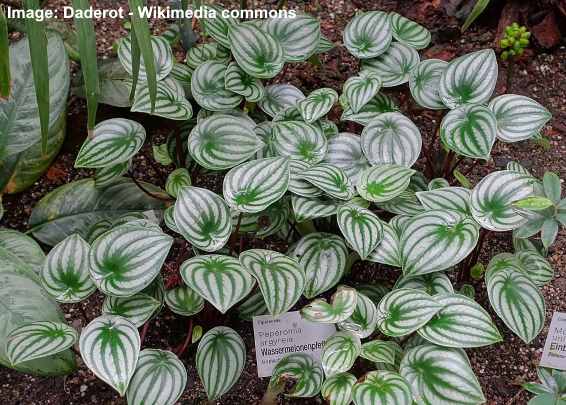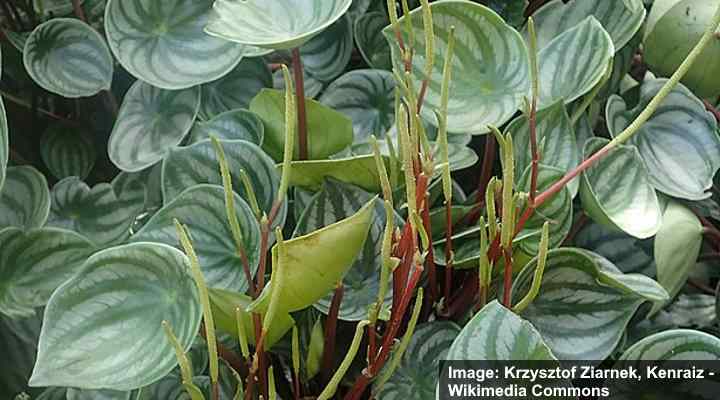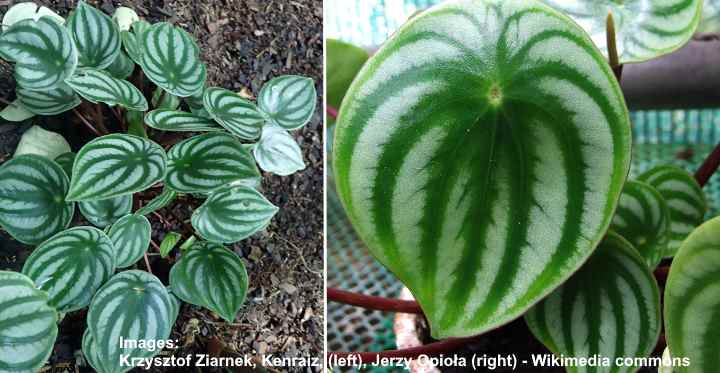Watermelon peperomia (Peperomia argyreia, previously known as Peperomia sandersii) is a beautiful houseplant with oval, green and silver markings on maroon-reddish stems and succulent-like waxy leaves. Watermelon peperomia plants may create flower spikes at the end of their lengthy stems. Bushy houseplants, which can grow up to 8 inches (20 cm) tall, are simple to cultivate at home.
This is a thorough guide to cultivating watermelon peperomia indoors. To bring greenery to contemporary living areas, you’ll discover valuable tips on caring for these attractive peperomia houseplants.
What is Watermelon Peperomia (Peperomia argyreia)

Watermelon peperomia is a tropical perennial in the Piperaceae family with elegant silver stripes on its ornamental leaves. Watermelon peperomia was once known as Peperomia sandersii, and it is now classified as Peperomia argyreia. Pepper plants are related to plants in the Peperomia genus.
Watermelon peperomia is named after the Greek word “argyreia,” which means “silvery” and refers to the striped markings on its oval green leaves. Since its fleshy leaves resemble the rind of a watermelon, Peperomia watermelon is known as ‘watermelon.’
Peperomia watermelon is also known as watermelon begonia due to its leaf form. Peperomia plants, often referred to as radiator plants, are heat-loving plants. The little, compact houseplants adore warm air and indirect sunlight, hence the name radiator plants. Peperomias, which include watermelon peperomia, prefer damp conditions and are native to tropical and sub-tropical regions.
How to Care for Watermelon Peperomia (Peperomia argyreia) — Overview
In bright light, sheltered from direct sunlight, grow watermelon peperomia plants. Water whenever the soil is half dry, and mist the leaves occasionally to boost humidity. Plant watermelon peperomias in loamy, well-draining potting soil. Between 65°F and 80°F (18°C and 26°C), Peperomia argyreia thrives. During the growing season, fertilize every month to encourage growth.
Watermelon Peperomia Plant Leaves

Watermelon peperomias have intriguing leaves that resemble small watermelons in this close-up picture. Silvery or cream-colored curving streaks run through the oval green pointed leaves. On reddish-maroon stems, watermelon peperomia leaves grow. Rounded leaves, akin to certain succulents, have a waxy feel.
Watermelon Peperomia Flowers

Watermelon peperomia plants produce green flower spikes on slender stems that look like green spikes. On the bushy plant, the little flowers are insignificant and hardly noticeable. Flower stalks may grow to be 2″ to 4″ (5 – 10 cm) long. Watermelon peperomias, on the other hand, are seldom seen blooming indoors. Watermelon peperomias are grown for their attractive leaves, not the flowers, by plant owners.
How to Care for Watermelon Peperomia
At home, we’ll look at the greatest technique to grow watermelon peperomia (Peperomia argyreia) plants. Your peperomia will grow for many years if you follow these growing tips. As gifts for friends, you may also grow additional watermelon peperomias.
Watermelon Peperomia Light Requirements
Bright, indirect light is ideal for watermelon peperomia plants. The variegated leaves retain their watermelon-like appearance thanks to plenty of light. Healthy development and vivid foliage thrive in a well-lit area. It’s important, however, to keep radiator plants out of the sun. Peperomia leaves may yellow and fade in color as a result of the sun’s scorching rays.
Watermelon peperomias prefer an east- or west-facing room for the best indoor location. Because of the lack of intense midday sun, this location ensures plenty of light. Keep the peperomia plants behind a sheer curtain or away from the windowsill in a south-facing room.
Plants that prefer low-light conditions are called watermelon peperomias. As a result, this peperomia plant may be grown in partial or full shade. Bathrooms, workplaces, and other areas with little natural light are ideal for growing compact plants.
If there isn’t enough light, watermelon peperomia growth can become leggy. Its stems may stretch as a result of a lack of natural or artificial light, and it may lose its compact shape. The red stems may grow long and untamed, with the watermelon designs fading from the leaves. Trim off the leggy stems and relocate the watermelon peperomia to a brighter location to promote compact plant development.
Best Soil for Growing Watermelon Peperomia Plants

Make sure to grow watermelon peperomias in well-draining potting mix if you want to take good care of them. By combining two parts peat moss, one part perlite, and one part coarse horticultural sand, you may make an ideal houseplant potting soil. Instead, growing potted radiator plants in a high-quality commercial potting mix might be beneficial.
The ideal balance of organic and inorganic materials such as gravel, perlite, or chicken grit is necessary for optimum watermelon peperomia potting mix. Peat moss is a lightweight, airy material that holds just enough moisture to remain loose. Perlite, in particular, is a good soil amendment for loosening potting soil to allow for excellent drainage.
Never let the roots of watermelon peperomia plants sit in waterlogged soil is the best tip for growing them. Roots rot and, ultimately, the plant dies in damp, soggy soil. Between waterings, you ideally want your peperomia soil to dry out quickly.
An optimal soil combination should become partly dry in a few days after a thorough soaking. Watermelon peperomia requires a certain combination of soil and chemicals, so this is one way to ensure you have it.
How to Water Watermelon Peperomia Houseplants
When the top layer of soil dries out, water watermelon peperomias. In the summer and during hot weather, you may need to water radiator plants once a week. Peperomias prefer less watering in the winter, perhaps every three weeks or so. Yet, to determine when to watering a peperomia houseplant, always follow the soil dryness.
Check to see if the top 2″ to 3″ (5 – 7.5 cm) is completely dry before you decide whether your watermelon peperomia needs water. Wait until there’s no moisture before watering, and then check again in a few days. Watering peperomias less often is preferable to watering them too frequently.
It’s worth noting that peperomias have succulent, fleshy leaves that store moisture and are drought tolerant. Fill the soil with water and allow the excess to drain away when watering a watermelon peperomia. Wait until the next watering until half of the potting mix has dried again.
The roots of this houseplant are properly hydrated thanks to this watering method. It is important to prevent overwatering by allowing the soil to dry between watering.
Here are some advice for watering Piteromia argyreia on a regular basis:
- Season—Watermelon peperomia, for example, has minimal development during the winter months. From November through February, the compact houseplants only need to be watered lightly.
- Climate—Moisture evaporates from the soil faster in warmer weather. In hot weather, you’ll need to water peperomias more often than in the winter months.
- Type of pot—Porous terracotta pots absorb water faster than clay pots, allowing it to escape. Therefore, when watering radiator plants, keep this in mind.
- Potting mix—Soil with a high organic matter level will hold moisture for longer, necessitating less frequent watering.
Watermelon Peperomia Temperature Needs

Watermelon peperomia plants thrive in temperatures of up to 30 degrees Celsius. Watermelon peperomia temperatures range from 65°F to 80°F (18°C to 26°C) in easy care. These tropical houseplants need a minimum temperature of 50°F (10°C). The climate requirements of watermelon peperomias are tropical and sub-tropical, with consistent warm temperatures.
Watermelon peperomias benefit from consistent temperature fluctuations, according to the best growing tip. You shouldn’t put them next to hot radiators in the winter, even though they’re called radiator plants. Keep tropical houseplants cool in the summer by keeping open windows and air conditioning vents away from them.
Ideal Humidity for Watermelon Peperomia
Watermelon peperomias prefer a humid environment. Watermelon peperomias adapt well to drier household air, despite their origins in warm, humid climates. Humidity requirements are low to medium. However, to mimic their natural habitat, mist the leaves from time to time. During the summer, misting watermelon peperomia leaves is common. Dry air can be created indoors by warm outdoor temperatures. Leaf misting may be beneficial in the winter if you have central heating.
Fill a spray bottle with filtered or distilled water to mist the watermelon peperomia plant leaves. Generate a fine mist over the plant’s foliage by setting the spray to its highest position. If necessary, mist the leaves once a week, or more often in the summer if they appear to be drooping. Watermelon peperomias can be humidified in a variety of ways, including the following:
- Watermelon peperomia should be placed on a pebble and water tray, allowing the moisture to moisten the leaves.
- For additional air moisture, grow watermelon peperomia plants with other houseplants.
How to Fertilize Watermelon Peperomia
Slow growers with modest fertilizing requirements, watermelon peperomias are ideal. During the growing season, apply a weak organic houseplant fertilizer every month to encourage proper development. Reduce the amount to roughly half of what the manufacturer recommends.
However, you may discover that your watermelon peperomia does well on its own without additional feeding. All the nutrients your potted peperomia needs are provided by organic fertilizers like tea compost, sea kelp, and plant extracts.
When caring for watermelon peperomias, here are a few fertilizing tips:
- Never apply fertilizer in late fall and winter because plant growth is dormant.
- To avoid mineral salts buildup, flush the soil every three months using synthetic fertilizers.
Repotting Watermelon Peperomia Houseplants

Watermelon peperomias are slow to grow and thrive when rootbound, so you don’t need to repot them often. When rootbound, little, compact houseplants flourish. As a result, they may only need to be repotted every two or three years. To encourage healthy growth, repotting is also beneficial because it refreshes the potting mix and replenishes soil nutrients.
You know when it’s time to repot a watermelon peperomia when you see roots poking out the pot’s drainage holes.
Select a pot one size bigger than the current container to repot your watermelon peperomia. Shake off loose soil and remove the plant and root ball from the pot. Trim any roots that are mushy, rotting, or have other indications of root illness. Fill the pot with an suitable potting soil and place the peperomia in a fresh pot. Make sure the plant is growing at the same level in the pot as it was previously.
Watermelon Peperomia Propagation
Rooting stem cuttings is the best way to propagate a watermelon peperomia plant. Snip off a leaf about 1 to 2 centimeters from the stem. Transfer the peperomia cutting to a sunny area, place it in a small jar of water. Roots should develop after a few weeks. Place the blade in a small pot of moist potting soil. Before watering the soil thoroughly, wait until it has dried.
The leaf cutting technique is the second option for growing watermelon peperomia. Take a leaf from the plant that is healthy and remove it. Next, for a few days allow the wound to callus by cutting the leaf in half horizontally on a paper towel. Then, immediately put the leaf cutting into moist soil. Until roots develop, cover with plastic to retain moisture and keep the soilmoisturestable.
How to Prune Watermelon Peperomia
Every spring, remove any leggy stems from watermelon peperomias by lightly pruning them. The growth of the plant is improved by trimming dead leaves and straggly growth. By focusing the plant’s energy into fresh growth, removing superfluous foliage encourages bushy development.
Are Watermelon Peperomia Plants Poisonous?
Cats, dogs, and other household pets are not affected by watermelon peperomia plants. Peperomia sandersii (Peperomia argyreia) is a non-toxic houseplant, according to the ASPCA.
Pests Affecting Watermelon Peperomia Growth
Common houseplant pests have little, if any, effect on healthy watermelon peperomia plants. A peperomia plant will survive for many years if you take care of it by not overwatering. Bright light also helps the plant become resistant to insects by promoting healthy development. Mealybugs are the most prevalent pest attacking withered watermelon peperomias. The cotton wool-like hairy substance that mealybugs leave behind on leaves can be used to identify them. Use a neem oil organic pesticide to get rid of mealybugs and other houseplant pests.
Add 2 tsp. of neem oil to a bug spray recipe. 1 tsp. of natural neem oil In a 1-quart (1 l) spray bottle, mix liquid dish soap and lukewarm water. To get rid of bugs, thoroughly mix and then spray the foliage of the plant liberally. To get rid of plant bugs, use the neem oil solution once a week. If you notice spider mites or whitefly infestations on your houseplants, you can also use the neem oil pest control spray.
Diseases Affecting Watermelon Peperomia Growth
You won’t have any plant diseases or infections if you take care of your watermelon peperomia. If you overwater watermelon peperomia plants, the only problem they have is. Roots rot and fungal diseases thrive in soggy soil. You should repot your peperomia to help it regain life if you believe it has rotting roots.
Trim off brown decaying roots, dispose of the old potting soil, and replace it with a fresh potting mix.
FAQs About Watermelon Peperomia Plant Care
Since they are easy to care for, watermelon peperomia plants are a good choice for beginners. The plant’s development, on the other hand, can be influenced by a few factors.
Why are my watermelon peperomia leaves drooping?
The most prevalent cause of drooping watermelon peperomia leaves is watering problems. The growth of a plant may be influenced by soil that is too wet or too dry. As a consequence, the stems weaken and wilt. Try to figure out the underlying reason for your watermelon peperomia’s death. Either stop watering the soil until it dries or replace the potting mix if it is moist and mushy.
Give the soil a thorough soaking and let the excess water drain out if it’s totally dry, such as when it’s dry around the roots. Check the potting soil every week for dryness and watering, if necessary.
My watermelon peperomia plant leaves are turning yellow, what should I do?
The sign of overwatering a watermelon peperomia is yellow leaves. By allowing potting soil to dry partially between soil drenching, you always ensure that you are watering houseplants correctly. Root rot, which is also induced by excessive watering the plant, may be indicated by yellow watermelon peperomia leaves.
